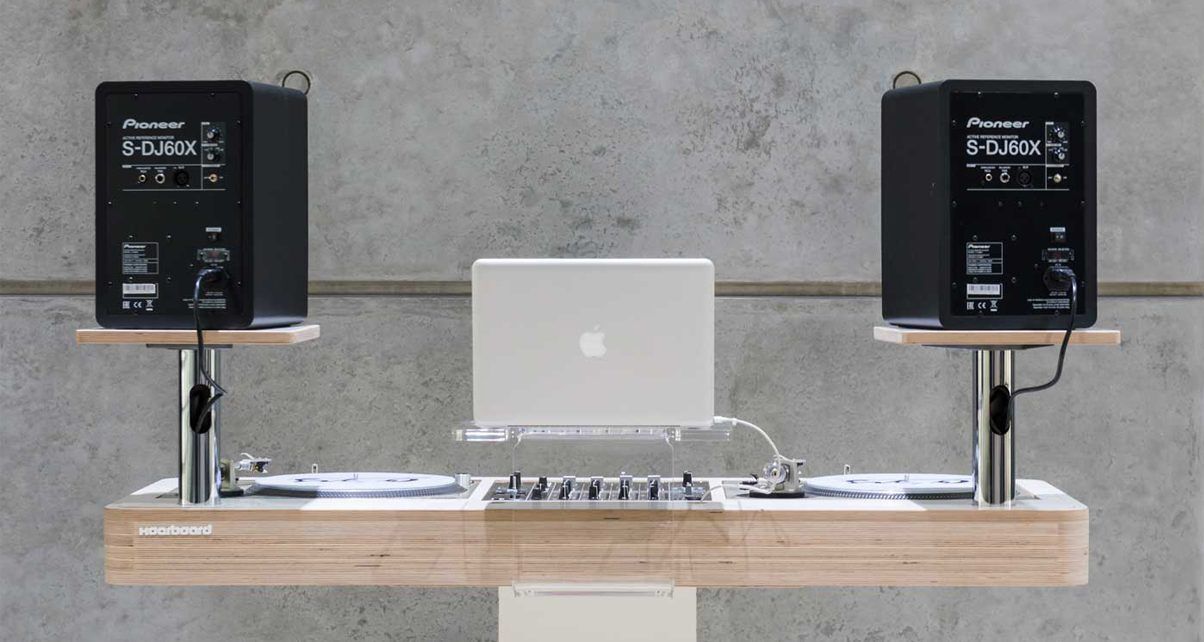Moving from the bedroom to playing out in public can be stressful for any DJ, and one of the most important aspects of a successful set is being able to hear what you’re playing correctly. The way speakers are set up in a club or lounge environment can be very different than what you may be used to in the bedroom, because there are typically two sets of speakers here: speakers that face the crowd which are the main speakers, and speakers that face the DJ inside the DJ booth, also known as booth monitors.
What are booth monitors?
Most DJs only have one set of speakers set up at home, facing them. In a bar or club environment this is not usually the case. The speakers connected to the main output are usually facing away from the DJ, towards the crowd. They also can be much further away from you that you’re used to at home.
Although the volume will be much louder than you’re used to, it can sound worse (because the speakers aren’t pointing at you), and the audio can also be delayed (since the speakers are further away – trust us, as soon as speakers aren’t near you, this becomes a real thing).
This means less enjoyment of your set, and more difficult beatmixing thanks to that delay between your headphones and the sound reaching you from your speakers – not good for any DJ, novice or experienced.
Booth monitors solve this issue. They are a second set of speakers connected to the booth output of the DJ mixer or controller, close to and facing the DJ. The booth monitors also have a separate volume control so a DJ can control the volume of the speakers he or she is listening to without affecting the volume of what the audience is listening to.
How to use booth monitors
Using booth monitors correctly takes a bit of practice. In the bedroom you normally only have one set of speakers and your headphones, while in a live environment you add another set of loud speakers to the equation which need managing.
The number one thing to remember is that the booth monitors are used as a representation of what the crowd is hearing, so you should learn to trust and rely on them 100% – try and ignore the “main” speaker volume when mixing entirely. The more you play live, the more you will realise how much proper booth monitors are important to sounding your best.
Unlike the main output speakers that will usually stay at a constant volume, it is common practice to constantly change the volume of your booth monitors. If you like to have a “party in the DJ booth” with your monitors up loud, when it comes to cueing your next song you may well choose to actually turn the booth monitors down in order to hear what is going on in your headphones better.
Some DJs prefer to leave the booth monitors off entirely when they’re not mixing, so they can get a better sense of what’s going on in the venue, or chat to other DJs in the booth, or whatever – if that’s you, of course you’ll be turning them up when mixing.
This back and forth of raising and lowering the volume can take some practice to get down as you learn to trust that whatever you do with your booth monitors, the main dancefloor can’t tell and doesn’t care!
Booth monitors are great, but they aren’t always there
There is a good chance that venues that have DJs on a consistent basis will have booth monitors set up. Although this may be the case for a lot of venues, there are plenty of venues that will only have main output speakers. As a DJ that takes your craft seriously you should prepare for the latter situation.
It’s a good idea to learn how to mix only using headphones. Turn your speakers at home off, use just your headphones, and record yourself doing a quick 15-30 minute mix. Use the “master cue” function on your DJ system, or the master/cue mix knob, to hear what is coming out of the main output in your headphones as well as the track you’re cueing up, much like you would using booth monitors.
Some DJs also like to use the “split cue” button, if it’s there, to “split” the cue and master audio, one to each ear-cup.
If you spin with a laptop, checking out your track’s waveforms (also known as “waveriding) is a practical solution to not having proper booth monitors because you can actually “see” if your mix is tight or not just by looking at the waveforms.
However you do it, after practising, listen back to what you’ve recorded to see how clean your mixes were.
Practising like this will help you prepare for when you do not have booth monitors and especially for such circumstances where due to the positioning of the speakers, what you are hearing out of the main speakers is too delayed and muffled to easily mix by.
Finally…
Remember, learning to use booth monitors is so important when you make the jump from the bedroom to playing for a crowd. They are one of the most important tools to make sure your mixes sound great for the audience you are playing for, and a rite of passage moving from bedroom to booth – so start practising now!
Have you played any gigs where the DJ booth didn’t have any monitors? How did you get around that? Let us know in the comments.


